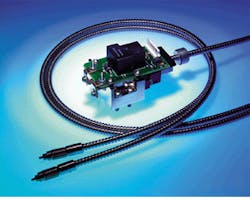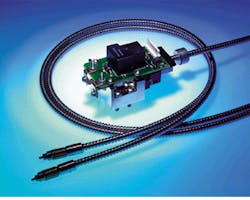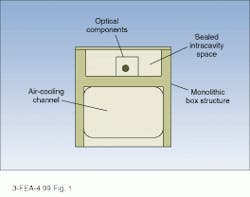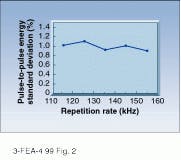Industrial lasers trim costs with diode pumping
Industrial lasers trim costs with diode pumping
Curt Frederickson, Mark Keirstead, and Michael Watts
With careful attention to laser design, diode-pumping delivers stable performance and long life, as well as increased wall-plug efficiency.
When diode-pumped solid-state lasers first became commercially available more than 12 years ago, they offered an order-of-magnitude increase in wall-plug efficiency over traditional flashlamps, together with freedom from large water-cooling systems. Laser manufacturers soon realized, however, that diode-pumping also had the potential to offer many other tangible benefits. Specifically, it has enabled an entirely new approach to laser design, setting new standards in terms of reliability, stability, beam quality, compact packaging, and simplicity of operation.
For industrial applications, these advantages translate into low cost of ownership and high process yields. With overall powers up to tens of watts and output from the near-IR to the UV, lasers designed in this way have come to dominate the low- to medium-power segments of the industrial market.
The intimate relationship between design and performance of these lasers is important because the advent of lower-cost, higher-power diode bars and stacks now promises a new generation of diode-pumped industrial lasers at considerably higher output powers. In order to maximize the value of this technology to end users, the benefits associated with lower-power lasers must be fully preserved in the scaling process.
Sealed "monolithic" cavity
Laser diode bars can have operating lifetimes of tens of thousands of hours, whereas flashlamps may need to be replaced every 1000-2000 hours. Because diode bars are significantly more costly than lamps, simple economics demands that laser designers capitalize on this lifetime difference. This is done in two ways--the laser must be designed for complete maintenance-free operation over the diode lifetime, and the design must protect the diodes in order to maximize their lifetimes. This can only be achieved using a fully sealed cavity.
In traditional lamp-pumped Nd:YAG lasers, the cavity is defined by various active and passive optical components that are supported on adjustable mounts on some type of base or rail. Because of the high peak powers, particularly in Q-switched models, this cavity is then enclosed. Typically, metal tubes and rubber bellows are used to "seal" the beam path, the goal being to prevent dust from settling on the optics, which would lead to damage. The entire assembly is then enclosed with a safety cover to prevent accidental operator contact with the beam or the high operating voltages. The interlocked cover is removed for periodic maintenance--replacing lamps and cleaning the optics--and for adjustment of the optical mounts, which inevitably drift over time.
This traditional approach does not support hands-free operation for many thousands of hours and is thus ill-suited for diode-pumped lasers. For example, even if dust is fully excluded, the rubber bellows and commonly used epoxy tend to outgas, depositing an absorbing layer on the optical surfaces. The laser controller can automatically compensate for the resultant power loss by raising the current through the diode bars; however, diode-laser lifetime has an inverse and nonlinear dependence on operating current. Frequent maintenance, downtime, and part replacement in diode-pumped lasers would make the effective cost of ownership too high for many industrial applications.
These problems of drifting alignment and contamination of optical surfaces are completely eliminated in high-performance diode-pumped designs by using a very compact, monolithic cavity that is truly sealed. There are several successful ways to do this. At Spectra-Physics, we rigidly mount all the optics along the cross-member of an I-bar structure (see Fig. 1). This I-bar arrangement delivers excellent torsional rigidity and stability. Also, even if the cavity temperature changes, the I-bar structure expands uniformly, ensuring that the optics stay perfectly aligned along the same axis. In addition, the optical mounts are all metal, with no out-gasing components. Because there is no need to adjust or clean the cavity optics, the head can be assembled and tested in a cleanroom and then completely sealed at the factory, fully protecting the optics from surface contamination.
Diode bar replacement
Use of diode lasers greatly simplifies replacement of the pump source. In a lamp-pumped laser, the pump light is directly focused into the laser rod by cylindrical optics. Whenever a flashlamp is replaced, the laser cavity must be realigned to optimize the mode-quality of the output beam. This requires a skilled technician, can be time-consuming, and usually results in a shift in output-beam alignment.
An elegant way to avoid these problems in diode-pumped lasers is to mount them in the power supply and then couple their output into the laser head using a fiber bundle. Because the relationship between the fiber end, focusing optics, and laser rod is never disturbed, there is no need for cavity realignment after diode replacement. This approach also minimizes thermal loading in the laser head.
At Spectra-Physics, our patented embodiment of this technology is called FCbar--a diode bar is permanently coupled to a fiber bundle at the factory (see photo on p. 127). Field replacement of one of these units is as simple as replacing a fuse, typically taking 15 to 20 minutes.
Benefits for industrial applications
There are now several diode-pumped Nd:YAG and Nd:YVO4 lasers from various manufacturers that incorporate all or some of these design principles. These high-performance lasers already have output powers as high as 20 W and offer several performance benefits for precision applications, such as marking, resistor trimming, and disk texturing. Their long, maintenance-free lifetime translates directly into cost of ownership benefits. With lamp-pumped lasers, time spent adjusting optics or replacing lamps is nonproductive downtime. In applications that require high beam quality, these optics have to be adjusted very frequently. But, with a diode-pumped laser, the beam quality remains consistently high throughout the lifetime of the laser and the beam direction never wanders. Also, a stable cavity design allows Q-switched diode-pumped lasers to deliver reliable pulse-to-pulse consistency, with energy variations as small as 1.5% rms, even at a 150-kHp repetition rate (see Fig. 2).
The stability of diode-pumped lasers also makes them advantageous in applications that use second-harmonic output at 532 nm or third-harmonic output at 355 nm. Because harmonic generation is a nonlinear process, any instabilities in beam quality and pulse energy are magnified at these wavelengths.
A look at a demanding, high-volume application such as disk texturing will make clear the value of the performance stability of diode-pumped solid-state lasers. In a computer hard disk, the read/write head is given a winged shape, so that it floats about 30 nm above the surface of the lubricated metal disk, which spins at up to 10,000 rpm. The disk surface is highly polished so that the head can safely float at such a small height. However, when the disk stops spinning, if the head rests directly on the polished surface, stiction problems may result. For this reason, a ring-shaped landing zone is produced around the disk center. This zone typically consists of 0.5 million separate surface bumps, measuring around 5 µm in diameter but only 20 nm in height. These bumps form a low surface area landing zone, thereby eliminating stiction.
Each circular, "volcano-shaped" bump is produced by an individual laser pulse from a Q-switched laser emitting at 1064 nm. A typical automated production machine must texture 3 million disks per year, which is a staggering 1.5 trillion bumps! At the same time, all these bumps must have the same height, within ۫ nm, to avoid undue wear and even damage to the disk head.
Unique Equipment (Chandler, AZ) is a leading supplier of integrated laser systems to the semiconductor and disk-drive industries, including fully automated workstations for disk texturing. Mark Dane, vice president of sales and marketing, says, "The power stability, stable M2, and long-term beam-pointing stability of the diode-pumped laser really make this application economically viable. Power stability and low, stable M2 value are important in ensuring that every bump will have the same shape and size. Beam pointing is just as critical, because the beam-delivery systems may include more than 20 optical elements to produce a diffraction-limited spot at the disk surface. A beam shift would lead to wavefront distortion and improperly formed bumps." Dane also notes that the small footprint of these air-cooled lasers is an additional advantage in that the bump-forming application is performed in Class 100 cleanrooms, where the effective cost of floorspace is very high.
Careful and clever design approaches have enabled the production of low- to medium-power diode-pumped solid-state lasers with high efficiency, long lifetimes, and excellent output characteristics. As manufacturers move to produce higher-power lasers, these proven approaches need to be extended if these benefits are to be preserved, rather than simply replacing the lamps in older designs with high-power diode bars and stacks. o
Remote diode bars are the key to simple and rapid field replacement. This can be even simpler using FCbar technology, in which the diode bar is permanently coupled to a fiber bundle.
FIGURE 1. A simple way to ensure long-term stability in a compact laser head is to mount the optical train on the cross-beam of an I-bar.
FIGURE 2. In a Q-switched diode-pumped laser, pulse-to-pulse energy variations can be as low as 1.5% rms, even at rep rates as high as 150 kHz.
CURT FREDERICKSON is marketing manager and MARK KEIRSTEAD and MICHAEL WATTS are product managers at Spectra-Physics Lasers, Mountain View, CA.



